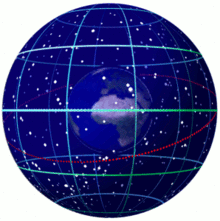Southern celestial hemisphere

The Southern Celestial Hemisphere or the Southern Sky, is part of a rotating astronomical region in the sky. It is the southern hemisphere of the celestial sphere.
Astronomy
In the context of astronomical discussions or writing about celestial mapping, it may also simply then be referred to as the Southern Hemisphere.
For the purpose of celestial mapping, the sky is considered by astronomers as the inside of a sphere divided in two halves by the celestial equator. The Southern Sky or Southern Hemisphere is therefore that half of the celestial sphere that is south of the celestial equator. Even if this one is the ideal projection of the terrestrial equatorial onto the imaginary celestial sphere, the Northern and Southern celestial hemispheres must not be confused with descriptions of the terrestrial hemispheres of Earth itself.
Observation
From the South Pole, in good visibility conditions, the Southern Sky features over 2,000 fixed stars that are easily visible to the naked eye, while about 20,000 to 40,000 with the aided eye. In large cities, about 300 to 500 stars can be seen depending on the extent of light and air pollution. The farther north, the less is visible to the observer.
The brightest stars are all larger than the Sun. Sirius in the constellation Great Dog has the highest apparent magnitude, at -1.5; it has a radius twice that of the Sun and is 8 light-years away. Canopus and the next fixed star Toliman (α Centauri), 4 light-years away, are also located in the Southern Sky, but with a declination of around -60° – too close to the south celestial pole that neither are visible from Central Europe.[1]
See also
References
- ^ David Ellyard, Wil Tirion: The Southern Sky Guide. Cambridge Univ. Press, Cambridge 2009, ISBN 978-0-521-71405-1
